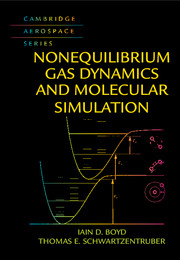Book contents
- Frontmatter
- Contents
- List of Illustrations
- List of Tables
- Preface
- Acknowledgments
- Part I Theory
- Part II Numerical Simulation
- 5 Relations Between Molecular and Continuum Gas Dynamics
- 6 Direct Simulation Monte Carlo
- 7 Models for Nonequilibrium Thermochemistry
- Appendix A Generating Particle Properties
- Appendix B Collisional Quantities
- Appendix C Determining Post-Collision Velocities
- Appendix D Macroscopic Properties
- Appendix E Common Integrals
- References
- Index
5 - Relations Between Molecular and Continuum Gas Dynamics
from Part II - Numerical Simulation
Published online by Cambridge University Press: 13 April 2017
- Frontmatter
- Contents
- List of Illustrations
- List of Tables
- Preface
- Acknowledgments
- Part I Theory
- Part II Numerical Simulation
- 5 Relations Between Molecular and Continuum Gas Dynamics
- 6 Direct Simulation Monte Carlo
- 7 Models for Nonequilibrium Thermochemistry
- Appendix A Generating Particle Properties
- Appendix B Collisional Quantities
- Appendix C Determining Post-Collision Velocities
- Appendix D Macroscopic Properties
- Appendix E Common Integrals
- References
- Index
Summary
In Part I of this textbook, the theoretical foundations of nonequilibrium gas dynamics were presented. In the second part of this textbook, computational approaches based on the material from Part I are presented that enable solutions to practical nonequilibrium flow problems. Since the continuum Navier–Stokes equations are widely used to obtain accurate gas flow solutions in the limit of near equilibrium, Part II of this textbook begins by analyzing the relations between molecular and continuum gas dynamics.
Introduction
The purpose of this chapter is to establish a rigorous mathematical link between molecular and continuum descriptions of a nonequilibrium gas. Specifically, the relation between the Boltzmann equation and Navier–Stokes equations will be presented. Carrying out this analysis is important for a number of reasons. In establishing this link, amore fundamental understanding of the Navier–Stokes model equations is gained and the mathematical theory is able to provide quantitative limits for the validity of the Navier– Stokes model.
This chapter contains the equations that connect interatomic forces to collision cross sections to the transport properties of gases. In fact, as we will see, the interatomic potential energy surface (PES) is themodel input for molecular dynamics (MD) calculations, the collision cross section is the model input for direct simulation Monte Carlo (DSMC), and transport property coefficients are the model input for computational fluid dynamics (CFD) calculations. Thus, as depicted in Fig. 5.1, the theory presented in this chapter rigorously establishes consistency between these numerical methods.
The procedure begins with the molecular description of a nonequilibirum gas presented earlier in Chapter 1. By taking moments of the Boltzmann equation, a set of averaged equations called the conservation equations are obtained. In the limit of near-equilibrium flow, the conservation equations reduce to the same formas thewell-known Navier–Stokes equations. By comparing the two sets of equations, rigorous expressions for macroscopic state properties and transport properties are obtained in terms of the properties of gas molecules.
In particular, the collision cross section becomes a convenient, physically meaningful quantity and general expressions for determining relevant collision cross sections are presented. The collision cross section is the most appropriate model for molecular simulations of dilute gases in nonequilibrium, and the equations in this chapter are referenced in Chapters 6 and 7, which describe the DSMC method.
- Type
- Chapter
- Information
- Nonequilibrium Gas Dynamics and Molecular Simulation , pp. 149 - 182Publisher: Cambridge University PressPrint publication year: 2017

